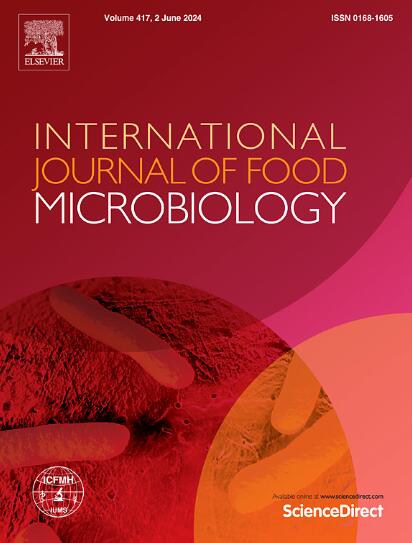Control of meat spoilage with ozone nano-bubbles: Insights from laboratory model systems and commercial scale treatments
IF 5
1区 农林科学
Q1 FOOD SCIENCE & TECHNOLOGY
International journal of food microbiology
Pub Date : 2025-02-21
DOI:10.1016/j.ijfoodmicro.2025.111128
引用次数: 0
Abstract
Ozone nanobubbles represent an environmentally friendly sanitation agent. In this study, we compared the bactericidal effect of ozone nanobubbles on pork muscle and adipose tissue to peracetic acid treatments. Pork samples were surface-inoculated with a cocktail of common meat-spoilage-associated microorganisms composed of Brochothrix thermosphacta, Latilactobacillus sakei, Leuconostoc gelidum, Carnobacterium maltaromaticum, Hafnia paralvei and Yersinia rohdei at a viable cell count of 102 CFU/cm2 or 104 CFU/cm2. Both freshly inoculated and stored pork samples were treated with the two sanitation agents, followed by differential enumeration of viable bacteria. Ozone nanobubbles were comparable to peracetic acid solution, achieving a reduction between 1 and 2 log (CFU/cm2), regardless of the initial inoculum concentration and sample type. The efficacy of ozone nanobubble increased with increased solution volume and flow rate. Moreover, the sanitizing agents differentially impacted the members of the microbiota and shifted the composition of tested strains during storage. Gram-negative Y. rohdei and H. paralvei were more sensitive to peracetic acid than Gram-positive strains. Microbial profiling using 16S rRNA gene amplicon analysis of samples that were treated at a commercial processing scale revealed that Serratia, Carnobacterium, Yersinia, Vagococcus, Morganella, Dellaglioa were the dominant taxa (relative abundance >1 %) on stored pork samples. The use of ozone nanobubbles significantly reduced the relative abundance of Vagococcus and Clostridium when compared to control samples. In summary, ozone nanobubbles are an effective tool to reduce bacterial counts on meat and show promise to extend the shelf life of fresh meat.
用臭氧纳米气泡控制肉类腐败:来自实验室模型系统和商业规模处理的见解
臭氧纳米泡代表了一种环境友好的卫生剂。在这项研究中,我们比较了臭氧纳米气泡对猪肉肌肉和脂肪组织的杀菌效果与过氧乙酸处理。猪肉样品表面接种由热嗜菌、酒氏乳杆菌、白僵菌、恶性肉毒杆菌、麻痹哈夫氏菌和罗氏耶尔森氏菌组成的常见肉类腐败相关微生物混合物,活细胞计数分别为102 CFU/cm2或104 CFU/cm2。用这两种卫生剂处理新鲜接种和储存的猪肉样品,然后对活菌进行鉴别计数。臭氧纳米泡与过氧乙酸溶液相当,无论初始接种浓度和样品类型如何,都能实现1至2 log (CFU/cm2)的减少。臭氧纳米泡的效能随溶液体积和流速的增加而增加。此外,在储存过程中,消毒剂对微生物群成员的影响不同,并改变了测试菌株的组成。革兰氏阴性罗氏耶氏菌和帕尔维耶氏菌对过氧乙酸的敏感性高于革兰氏阳性菌株。利用16S rRNA基因扩增子分析商业处理样品的微生物图谱显示,沙雷氏菌、肉杆菌、耶尔森氏菌、迷走球菌、摩根氏菌和德拉氏菌是储存猪肉样品的优势分类群(相对丰度>; 1%)。与对照样品相比,臭氧纳米气泡的使用显著降低了迷走球菌和梭状芽孢杆菌的相对丰度。总之,臭氧纳米气泡是一种有效的工具,可以减少肉类上的细菌数量,并有望延长鲜肉的保质期。
本文章由计算机程序翻译,如有差异,请以英文原文为准。
求助全文
约1分钟内获得全文
求助全文
来源期刊
CiteScore
10.40
自引率
5.60%
发文量
322
审稿时长
65 days
期刊介绍:
The International Journal of Food Microbiology publishes papers dealing with all aspects of food microbiology. Articles must present information that is novel, has high impact and interest, and is of high scientific quality. They should provide scientific or technological advancement in the specific field of interest of the journal and enhance its strong international reputation. Preliminary or confirmatory results as well as contributions not strictly related to food microbiology will not be considered for publication.

 求助内容:
求助内容: 应助结果提醒方式:
应助结果提醒方式:


